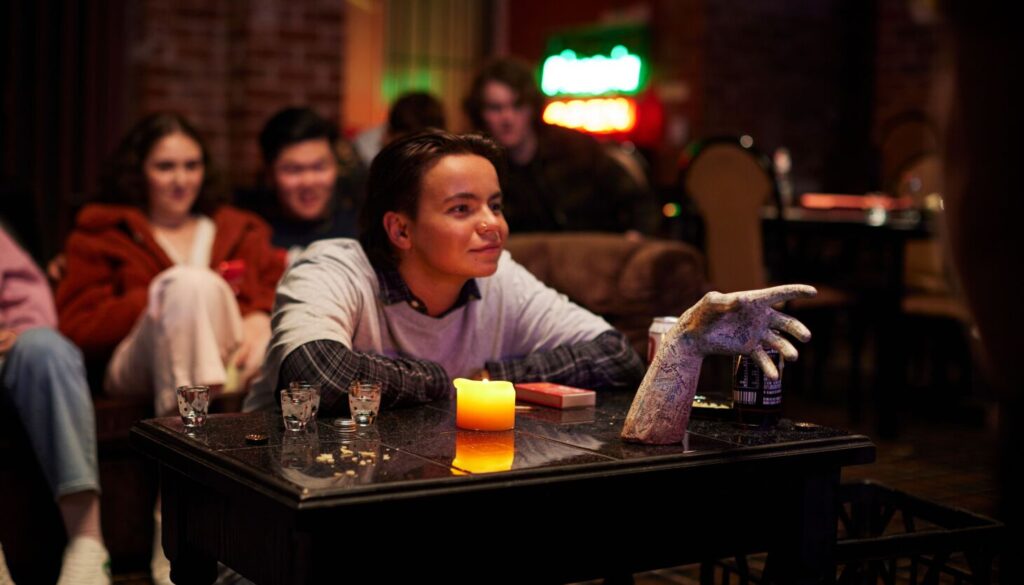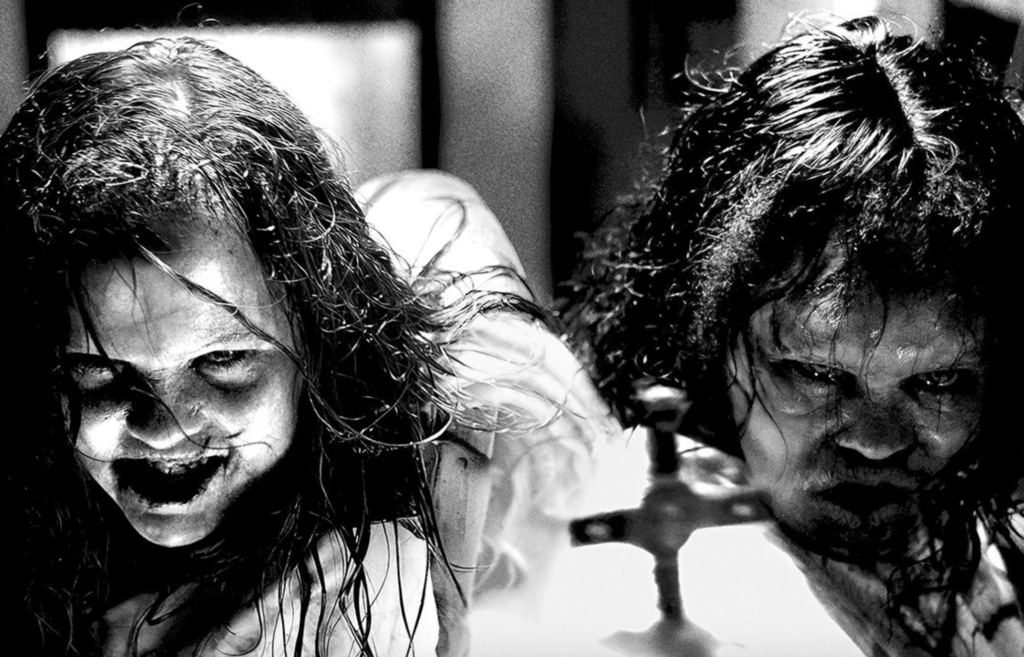Oooh-oooh-ahh-ahh-ahhhhh. It’s that most gorrrriest time of the year. Which means, in addition to some eyeballs and fresh liver, I shall serve you a horrifying script review. As David Pumpkins would say… any questions??
Genre: Horror
Premise: Two young Indian brothers living in England head back to their dying grandmother’s home in a remote part of India only to learn that her house may be haunted.
About: This script finished on last year’s Black List with seven votes. The writer has worked on a couple of small movies as a crew member. He’s still looking for that first writing credit.
Writer: Vikash Shankar
Details: 118 pages
 Ms. Marvel’s Rish Shah for Dev?
Ms. Marvel’s Rish Shah for Dev?
I chose this horror script today to get you in the Halloween Logline Showdown mood! Send me the logline for your Horror or Thriller script by next Thursday night. The five best loglines will compete over that weekend. It’s going to be a spoooooooooky fun time.
What: Halloween Logline Showdown
Send me: Logline for either your Horror or Thriller script (Pilot scripts are okay!)
I need: The title, genre, and logline
Also: Your script must be written because I’ll be reviewing the winning entry the following week
When: Deadline is Thursday, October 19th, by 10:00pm Pacific Time
Send entries to: carsonreeves3@gmail.com
Okay, onto today’s horror script.
We’re constantly told as writers to bring the reader somewhere new, somewhere fresh. And yet, often times, when we do that, the feedback we receive is, “It’s a little too out-there.” “It’s too inaccessible.” “Not marketable enough.”
Today’s scripts is the perfect example of that. The writer is doing what you should do, which is find a new avenue into the horror genre. Take us somewhere unique. Because that’s where you’re going to find all the fresh scares.
But I’m guessing that the majority of you saw this logline and thought, “Ehh. Not interested.” “A horror story set in India? Not my jam.” I know this because it’s the reason it’s taken me so long to review it. Whenever I see the logline on the Black List, one of those two thoughts pops into my head and I move on. Which is why choosing a concept as a writer is so hard. You’re trying to hit that elusive target of “fresh but familiar.”
The good news for the writer is that it’s still horror. And horror sells. So if he’s a good writer and he’s come up with a scary story, he can overcome our bias. Let’s take a look.
Dev, 18, and his little brother Sid, 13, live in London circa 1989 at a foster care home called “Bring Them Home.” Dev is at the end of his foster care service and is desperately working the government system to get custody over Sid so that they can live together.
That’s when Dev learns that their grandmother, who lives in India, is clinging to life, which means that they may be inheriting money. This would solve Dev’s problem of taking Sid out of foster care. So the two head out to Varanasi, India to their grandmother’s place, a large rural farm house.
Once there, Grammy dies pretty quickly and Dev and Sid work with their aunt, Parvati, not related to the opera singer, to try and sell the house. As we’ve established, Dev needs that money badly. The problem is that the villagers in the area all think the house is haunted.
This is where Dev and Sid learn about why their parents got rid of them. Long story short, there used to be a lot of child labor here and the parents were afraid that Dev and Sid would be sent off to work the fields their whole childhood. Which is a load off of their backs since they always assumed their parents hated them.
It turns out their parents story is a lot more complicated, though. The land they’re on is sacred and a lot of the neighbors thought that, if they sacrificed their own children on the land, that God would look over them. So there were a lot of child sacrifices here. Their father, in an attempt to stop it, burned everything, including his wife. It looks like something survived this burning, though. Something evil. Something that now wants to claim Sid.
One of the great things about horror movies is that if you’re clever with your soundtrack and your cinematography, you can hide a lot of script problems. You can literally loom on a shot of a church from a low angle for 60 seconds, with a slow zoom-in, accompanied by some “Exorcist-like” piano chords, and you look like the most visionary director ever.
I get the sense that this script was designed under that principle. It wants to be a movie first and a script second.
Unfortunately, that’s not how it works. The script always comes first. That’s where you build your story. But Shankar is so into the details of his world – the imagery that is going to make the movie look so great – that he forgets to move his story along at an acceptable pace.
There’s a moment on page 56 where the priest, Anand, has Sid and Dev grab a giant pot and perform an elaborate fire ritual with it.
He tells them, “The soul’s liberation from its physical form in this life and the next. It can take its rightful place in the Cosmos knowing its fulfilled its duties here on Earth.” Sid looks at him inquisitively. “Didn’t we already do that?”
WHICH IS EXACTLY WHAT I WAS THINKING.
Just eight pages ago (!!!) we had a scene where they did a ritual with burning her body that helped her get to the next life or something. It’s the same scene!
You never want to repeat beats in a screenplay. I can’t emphasize how quickly the reader gets bored. If you’re going to repeat plot beats? You are opening the gates of boredom.
And, oh yeah, you read that right. We’re still dealing with the grandma’s death on PAGE 56!!!! We should be WAY PAST that by now. The grandma should be dead and gone by the end of the first act.
We need to start a mandatory course for all screenwriters going forward to read Scriptshadow. Because if they did, THEY WOULDN’T MAKE THESE MISTAKES. I’m saving your scripts from disastrous errors if you’d just listen!
The one thing the script has going for it is an extensive, and quite imaginative, mythology. Kudos to Shankar for conceiving of this child-sacrifice backstory as it is definitely not something I’ve seen before. But even that great part of the script is overshadowed by endless detail and lackluster pacing.
Something all horror writers should be aware of is that if you’re stuck in one location – which often happens with haunted house scripts – you need to move your plots along quicker because we’re going to get bored faster in contained locations. Characters sitting around is script ambien. So you need your plot to offset that.
Having your inciting incident – the grandma dying – on page 45 (and then lingering on the death for another 10 pages) is guaranteeing that the script ambien is going to set in.
I also thought Shankar missed some creative plot opportunities. Whenever you’re dealing with haunted house movies, you have to be able to answer the question, “Why don’t they just leave?” In this story, the grandmother screams at them to leave as soon as they come. Then dies under mysterious circumstances. Pavarati and his orchestra go tumbling down the stairs and almost die, also under mysterious circumstances. Sid seems to see a new monster every night when he goes to sleep.
So why is Dev staying? Especially since nobody wants to buy the house due to it being haunted.
A cool plot choice that Shankar could’ve used was to make the priest sketchy. For starters, you get irony, which is always great. Since the priest is the one telling Dev that he won’t be able to sell the house, Dev should think that the priest is lying. And that, as soon as they leave, the priest will take the house and sell it for himself. That’s why Dev stays. Cause he thinks he’s being played. The priest is lying about all this haunted nonsense so he can make some cash. This would’ve also given you more conflict to work with as well, which is great for any story.
Irony. Better Logic for why Dev stays. Conflict.
That’s three great things with just one smart creative choice.
I suspect, if Shankar is directing his script, that the final product will be better than the screenplay. But even if he directs the roof off of this thing, I don’t think the movie can overcome the leisurely-paced story. This script needs a faster pace to get the most out of the concept.
[ ] What the hell did I just read?
[x] wasn’t for me
[ ] worth the read
[ ] impressive
[ ] genius
What I learned: Action turbocharges description – “Dev and Sid fan themselves in the heat, glistening with sweat.” This is a good example of how to convey relevant description. You add an action to it. This line could’ve been, “Dev and Sid ride in the car, their foreheads glistening with sweat.” That tells us that it’s hot, yes. But there’s something about adding an ACTION that resonates more with the reader. That action of “fanning themselves” conveys how hot it is.
Genre: Action/Period/Heist
Premise: A unit in the American army in World War 2 goes AWOL in an attempt to steal looted treasure from a Nazi train.
About: This script sold for a million dollars back in 1989. Disney snatched it up the second they read it. Unfortunately, the writing team, Rick Jaffa and Doug Richardson, would nearly come to blows after the sale and never wrote another script together. But Richardson would go on to write Die Hard 2 and Jaffa would become one of the most successful screenwriters in the business. You may have heard of a little movie he penned called, “Avatar: The Way of Water.”
Writers: Rick Jaffa & Doug Richardson
Details: 128 pages

Suits’ Gabriel Macht for Mac?
Today we’re going to discuss an overlooked screenwriting topic – the faulty premise.
The faulty premise should be up there in the top 5 of every screenwriter’s “avoid at all costs” list. This is because a faulty premise cannot be fixed through rewrites. So what ends up happening is that you rewrite and rewrite and rewrite the script, to the point of almost perfect execution… but it doesn’t matter. Because the premise is still faulty.
We’ll talk about this in more detail after the plot synopsis.
It’s World War 2 and the tide is turning for the Allies. It’s looking like evil will be usurped. But that doesn’t mean there still aren’t a lot of gnarly battles going on.
We meet universal problem-solver and effortlessly cool, Mac Mccann, when he’s blowing up a train tunnel to stop any future Nazi trains from getting through. Mac’s superior, a guy named O’Connor, HATES Mac, mainly because Mac doesn’t play by the rulebook (he’s the only guy in the military with long hair) yet always wins in the end, getting all the glory.
After liberating a small Italian town, Mac and his unit – which includes Sewage (big and dumb), Hands (great with his hands), Lips (can talk himself out of anything), Rex (an actor), and Pope (religious) – have been revealed to have hit up a local Italian bank and stolen all their money. It turns out Mac and his crew are using this war to line their pockets.
So it’s not surprising when they hear that the Nazis are loading up on treasure from the Jews and anyone else they can steal from, that Mac has the brilliant idea to rob the train all this treasure will be transported in. This’ll ensure that when they get back stateside, they’ll be drownin’ in monaaaaaaay.
There isn’t much resistance from his crew so off they go – DIRECTLY INTO GERMAN OCCUPIED TERRITORY. This requires them to steal a German truck and dress like German soldiers. And it turns out that, except for Rex, none of these dingbats is very good at pretending to be German. They’re identified at the very first checkpoint they cross.
But they somehow escape, keep traversing, meet up with a marooned all-black tank crew, have to steal another tank from a local village, before they’re able to head the Treasure Train off at the pass and enact their final plan. But will they be able to execute said plan? And what happens when one of the cars turns out to be carrying something more than treasure?
Okay, did you note the faulty premise?
Actually, you should’ve spotted it in the logline.
You can’t have the primary goal of your heroes be to steal treasure that comes from innocent civilians in World War 2. Maybe you could pull it off if this was set in the modern day. But a lot of this is Jewish treasure. To have your heroes stealing from Jews in World War 2…. I’m sorry but there’s no way you can make us root for those characters. It’s too big a hill to climb.
The way you do it is the way Indiana Jones does it. He steals treasure and gives it back to its rightful owners.
Now, whenever I see a writer do this, they always try and backtrack later on in the script. So, in the case of “Hell Bent and Back,” once Mac and his team are on the train, they discover that one of the cars is full of children. Which leads to Mac having to decide whether he wants to save the children or take the treasure.
Of course, he chooses the children. And it’s actually a well-executed character arc. This guy has been all about the Benjamins for two hours. But he finally changes, realizing that helping others is more important.
The problem is, it doesn’t matter because you’re still subjecting the reader to two hours of your character wanting to steal Jewish World War 2 treasure for himself. You can’t make up for that.
Which is too bad because the script is actually fun.
It has a bunch of well-done set pieces. There’s an early one where Mac’s unit, dressed as German soldiers in their German truck, come across a checkpoint and the real Germans inspect the truck. The Germans suss out that something is off and the next thing you know, it’s complete mayhem.
I love when writers do this. Because what usually happens in the scripts I read is that the writer will protect his protagonists. He’ll make sure, when his characters get to this checkpoint, that the bad guys never get too close to figuring them out.
In writing, you never want to help your protagonists. If anything, you want to be your protagonists’s worst enemy. You want to make their lives a living hell. If they’re at a checkpoint, don’t take the easy way out. Have the Germans realize who they are. I guarantee your scenes will be way more exciting once you adapt that principle.
The script definitely has an old-school feel to it. In that sense, it does things that I miss. There’s this entire set-piece in a small town where Mac’s unit is trying to secure a tank – and the writers take their time, set it up, build it, cover it from multiple character angles – so by the time the Germans figure out what’s going on, it results in a giant climax that’s emphatically earned.
You don’t see that in today’s movies much. We move in and out of these big sequences without the requisite setup, without the use of suspense. It’s slam, bam, thank you crayola crayon, and, therefore, it feels empty. Like it’s over before it started. Don’t be afraid to build up your set pieces. The reader will afford you as much time as you want as long as we feel like we’re building towards a big cool moment.
This script reminded me of a really REALLY early prequel to Guardians of the Galaxy, as strange as that may sound. Mac is Starlord. Sewage is Drax. Lips is Rocket Raccoon. The characters even start out in prison. It goes to show how dependable this formula is. I just wish they’d have found a non-faulty premise. Cause that’s clearly why this movie never got made.
Script link: Hell Bent and Back
[ ] What the hell did I just read?
[ ] wasn’t for me
[x] worth the read
[ ] impressive
[ ] genius
What I learned: If you’re ever lucky enough to get your script as far up the food chain as Hell Bent and Back, one of the biggest things that will be scrutinized is: Will we root for these characters? And if the characters are doing something reprehensible, then the studios are not going to pull the trigger. It’s too risky. If you want to write more interesting material where your heroes exist in that moral gray area, that’s fine. But you’ll have to write stories that have a much lower budget. Cause if you’re writing something that costs as much as Hell Bent and Back? I guarantee you they want their protagonists to be likable.

So I’m sitting there watching Talk to Me, the A24 Australian horror movie you might have seen the trailer for. It’s the one where a bunch of teenagers are in a basement and one of them holds a hand statue and then goes into some sort of trance.
The movie is pretty good. But it made its fair share of screenwriting errors. Basically, the plot goes like this. A teenage girl, Mia, hangs out with this family all the time because her mom died. She’s got her friend, Jade. And then Jade’s younger brother, Riley.
This trio occasionally hangs around a cool group at school, led by tough-chick Hayley, and Hayley’s muscle, Joss. This group loves to play this game called, “Talk to Me,” where they bring out a hand statue, strap you into a chair in front of it, you hold the hand and say, “Talk to me,” then follow that by saying, “I let you in.”
As soon as you say, “I let you in,” whoever’s in the chair sees a [usually gruesome] dead person sitting in front of them. Nobody else in the room can see this. Just the person in the chair. This creates a level of doubt where everyone can write the experience off as fake, much like when two people push the planchette on a Ouija board. You can always blame the other person as the pusher.
Except everyone in the room participates in the experience so that sort of negates the idea that they’re faking it. But we’re not going to nitpick.
Mia seems particularly affected by her experience, where she saw a couple of gnarly dead bodies. But it’s when Riley goes under that the crap hits the air conditioner. Riley is channeling Mia’s dead mother.
Mia is so taken by the chance to talk to her mom that she prevents Riley from stopping the experience before the mandatory 90 seconds. Riley starts going ballistic, bashing his head into anything he can find, nearly killing himself before they’re able to detach the hand from him.
This results in Mia being banished from the family, which sends her back home to hang out with her dad. When Mia sees her mother’s apparition again, she finally answers the question about whether she killed herself. She didn’t. And the person who did is two rooms away from her. Her father. Time to run.

You may have snooped out a couple of the screenwriting issues from that synopsis. The first is that the possession rule is shaky. In fact, we’re not even sure people are being possessed for three-quarters of the movie. Mia is not possessed despite going through the process. She sees other spirits, like her mom. But she’s not possessed.
Then, near the end, we lean heavily into the injured Riley being possessed. And then, of course, Mia’s father being possessed. Whoever’s inside of her dad is trying to kill her.
You can tell that the writers started to realize near the end of writing the screenplay that, “Oh, they’re possessed! So we can do something with that!” So then they rush to pay off a possession storyline that they never really set up.
It’s fine to do this. It’s a natural part of screenwriting. You figure things out while you’re writing the script. But once you figure something big out, you have to go back and properly set it up.
Ditto the dad. They didn’t even mention the dad for the first 70% of the movie! I didn’t know she had one. How could I? She was always at this other house. And the writers leaned heavily into this idea that this other family was taking care of Mia. So we assumed she didn’t have family.
To not only tell us she had family, but to build the crux of Mia’s entire storyline around what her father did to her mother was clunky to say the least. A good screenwriter is going to realize that if they want to use this ending, they need to go back into that first act and properly set up the dad. Then keep him in the story throughout the second act.
As I was pondering all this, a question popped into my brain: Does it matter? Or, more specifically, would this have mattered in regards to how well the movie did? It’s got a 94% critic score on Rotten Tomatoes. It’s got an 82% audience score. It made 50 million dollars in the U.S. and nearly 90 million worldwide.
Would making those changes have affected these numbers in a positive way? Because if you look just at the movie, it’s really well put together. The main actress who plays Mia, Sophie Wild, is great. She’s going to become a star. The rest of the cast is really good. There are no weak links.
The cinematography is great. The directing overall has no weaknesses (they were particularly convincing in creating a “teenage atmosphere”). Also, the hand sequence WORKS. Whatever it is at the center of your fantastical story, it has to be convincing for the viewer to suspend their disbelief. If it’s hokey or dumb, they’ll immediately check out. And the “talk to me” stuff was perfect.
Most importantly, the movie was scary. I did the thing where I put my arms up in front of my face half-a-dozen times cause I saw something weird in the corner and it started moving and I didn’t want to know what the f*** it was.
So, if you do those things: You have a convincing mythology, you have plenty of legitimate scares, you have characters who we’re on board with – you can make screenwriting mistakes and it be okay. It’s similar to what I tell comedy writers. If your script is funny, you can have the worst plot ever. It doesn’t matter. Ditto with horror. If it’s scary, you can make mistakes.
But the purist in me still believes that if you fix those mistakes, your movie is going to have better word-of-mouth which means more people are going to want to see it. I think it’s telling that the audience score is lower than the critical score here. Audiences may have been a little frustrated by the sloppiness in the storytelling.

Look no further than what happened to Exorcist: Believer this weekend. Now I didn’t see the film. But I knew that the baseline they were building predictions off of was 30 million. Because that’s what the predicted ROI was for this particular advertising package. Now, the box office could go well above that number or below it. And it depended on if the story was good.
Guess what?
It wasn’t good. It has a 22% Rotten Tomatoes score and a 59% Audience score (which will probably go down once more reviews come in). It was made clear early on on social media that this one was a stinker. And so all those potential moviegoers who were thinking about going on Saturday who were going to pump up that box office to the high 30s, maybe even 40 million dollars, they decided to stay home, and the movie made 27 million bucks.
In David Gordon Green’s defense, I’ve never been able to figure out the key difference between an exorcism movie that works and one that doesn’t. For all intents and purposes, the original Exorcist should not have worked. It’s long. We’re stuck in this house the whole time. Some characters disappear for 90% of the movie. Others show up halfway into the movie.
I just remember that movie feeling so real. It felt like how an actual exorcism situation would happen. That realism is what sold it for me. And even though all these exorcism movies since have given us convincing possession performances, none of them has felt as authentic as The Exorcist.
In other words, trying to recreate the authenticity of one of the most authentic horror movies ever is a hard task to pull off. None of the other Exorcist sequels have been able to do it. I’m shocked, like the rest of the industry, that Universal paid 400 million for the rights to try and change that pattern. A lot of people thought they were dumb. Believer’s critical and audience reception is proving them right. It looks like this franchise is going to end up on the bottom of a concrete stairway.
This is a friendly reminder to get those Horror and Thriller loglines in for the big Halloween competition. I am DETERMINED to find a great genre screenplay on this most wonderful of holidays. Keep’em coming!
What: Halloween Logline Showdown
Send me: Logline for either your Horror or Thriller script (Pilot scripts are okay!)
I need: The title, genre, and logline
Also: Your script must be written because I’ll be reviewing the winning entry the following week
When: Deadline is Thursday, October 19th, by 10:00pm Pacific Time
Send entries to: carsonreeves3@gmail.com

Reviewing “Seven” in my newsletter brought me back to a time when screenwriters could change their lives overnight. All they had to do was a write a good screenplay and – BOOM – they were millionaires.
Those sales then did double-duty for them, as their names would be splashed all over the trades. This would result in everyone in town wanting to meet with them. Which would establish contacts for these writers that they could use to write high-paying work for the next decade.
What happened to that world and how can we get it back?
A number of things happened. For starters, the internet screwed up the agency’s con. A big part of how scripts got sold in those days was that an agent would send a script out (hard copies, remember, not pdfs) to 7 studios and because all parties were isolated from one another, studios would freak out, afraid to lose a hot spec to a competitor, and therefore bid on that script out of fear, regardless of it it was any good.
Once the internet arrived, Roy Lee, a producer now at Warner Brothers, created an online chat room where assistants could share their thoughts on scripts. Therefore, when a script went out this time, it got photocopied quickly and, within hours, everyone was reading it. These assistants now had a central location to share their thoughts on the script, which would allow a quick consensus on if a script sucked or not.
And here’s the open secret about agency-endorsed screenplays (both then and now) – most of them are bad. Now, that badness was being exposed. So that previous strategy of scaring studios into bidding on bad material didn’t work anymore. This killed a lot of sales that would’ve gone through in the previous era.
Another thing that happened was that the studios all agreed not to share sale numbers anymore. They did this because the news stories about scripts selling for 2 million dollars were driving up script prices. So if you stopped telling people how much a script sold for, the trades were less likely to write a big story about them. And this would allow the studios to bring script prices down to a reasonable level.
I still don’t understand why agents agreed to this. It’s in an agent’s best interest to promote a big spec sale because it will get their client more work as well as themselves more money. The conversation may be more nuanced. I know that, sometimes, a script would sell for a lot less than expected and, in those cases, the agents would want the script price to be vague. That way they could hint that it was bigger than it was.
But just the fact that the trades no longer posted these numbers hurt the script sale business immensely.
But now we get to the biggest reason spec script sales plummeted – THE SCRIPTS WERE BAD. Go ahead and read some of these old million dollars sale scripts. Or just go back through my archives. They’re in there. These scripts were average at best. And so, when they got made, they didn’t make enough money. And when that happened enough times, the studios said, “We’re not following that carrot anymore. We know where that carrot leads.”
The inflection point was 2014’s Transcendence, with Johnny Depp. That was a spec script. That was an expensive movie. And it just SAT THERE. Nothing happened in that screenplay (which I erroneously gave a decent review to). So nobody showed up. And I specifically remember the drop-off of script purchases that occurred after that movie’s first weekend. And the market never recovered.
Which leads us to the post’s big question: How do we bring spec script sales back?
For one, trades have to write about them again. One of the reasons spec scripts became so big in the first place was all the stories that the trades would write about them. If someone sold a big spec, there’d be a giant Variety article that would go into detail about the writer – where he came from, how he conceived of the idea. It was exciting! I still remember reading that article about those valet guys who wrote a spec about valets that made a million bucks. Those stories drive interest in screenwriting. We need them. And nobody writes them anymore.
I’ve thought about writing them myself. But there is some conflict-of-interest. When I have made some calls to get info and developed relationships with those buyers in the past, it would get complicated when I would then have to review the script (or another script from the same production company). I’d notice that I was a little easier on the material than I would normally be. But it’s something I should consider because that sacrifice could be worth the industry having a place where they can consistently read the latest screenwriting success story. Let me know in the comments if you think I should do this. It might mean not being able to review those scripts, though.
We need to publish script sale numbers again. Agents and managers should be promoting those numbers like crazy. It’ll lead to their clients making more money on future projects! Which means more money for them! I don’t care if these spec sale prices are low at first (250 grand, 350 grand). They will grow over time if we keep our foot on the gas and keep writing about these sales.
But the biggest thing you, the writers, need to do is write THE RIGHT SCREENPLAYS and then do a GREAT JOB WRITING THEM. These scripts don’t only have to be as good as the mega-franchise movies. They have to be better. Cause they don’t have any IP behind them. So if you’re a studio taking a chance on one of these scripts, the script has to be really impressive.
Ever since the spec sale business died, the primary measuring stick for a screenplay has been The Black List. And The Black List has become the opposite of the spec sale business. It’s become the Nicholl Fellowship List. It promotes intellectual screenplays over commercial screenplays. It still serves the purpose of getting writers recognized. But it doesn’t help the spec sale trade at all.
To revive the spec sale trade, you have to start with the kind of movie template that actually makes money. Former spec script mainstays like Comedy (The Hangover), Dark Thrillers (Silence of the Lambs), Romantic Thrillers (Fatal Attraction), and Romantic Comedies (Notting Hill), have been relegated to streaming services. Which means you can still make money off of them. But it’s not going to be for a big paycheck.
The movies that spec writers can still write these days and realistically sell for big money include the Action movie (Beekeeper), Action Comedy (Spy), Horror (Us), Buddy Cop movies (Central Intelligence), Guy/Girl with a Gun movies (John Wick), Fun Slasher movies (Scream), Heist (Ocean’s 11), Biopics (Elvis), Based on a true story World War 2 movies (Saving Private Ryan), Contained Thrillers (The Mist), Fun Undercover Cop movies (the original Fast and Furious, Point Blank), Ensemble Big Concept (Knives Out) and to some extent, the general high concept script, as long as it’s upbeat and therefore would sell a lot of tickets (think Jurassic Park or Free Guy).
This is not to rule out updating old templates, like the Submarine movie (Crimson Tide), the Action-Crime movie (Heat), Hitchcockian Suspense movies (Gone Girl), The John Carpenter movie (Escape from New York), The John Hughes movie (elevated teen fare), the big-budget Western (The Magnificent Seven), the pirate movie (Pirates of the Caribbean). Or just that bonkers wowza idea that’s never been done before.
To be honest, you could still write a rom-com that sells for a million bucks *if* you find a clever way to reinvent the genre. Actually, that’s the best way to sell any script for a million dollars. Reinvent the genre. Reinvent any of the movie-types I listed above and you can be a millionaire. I’m not kidding.
Once you’ve got your concept, the hard work begins. This is where the article comes full circle because “Seven,” in many ways, is the perfect spec script. It’s not only a clever idea. But it’s one of the few spec scripts I’ve read where it’s clear that the writer gave 100% on every page. There’s zero laziness in “Seven.”
The core reason that the spec boom died out was that the movies that resulted from those scripts didn’t consistently deliver. And that’s cause the scripts were weak. Most of the value in those scripts was concentrated in the first act. Which meant audiences would go to the theater, enjoy the heck out of the first 30 minutes of the movie, then became increasingly bored with every passing ten minutes. They’d leave the theater with zero energy and wouldn’t recommend the movie to anyone.
So if you want to revive big spec sales, it’s up to you guys. It’s up to you as to how much you want to work on your screenplays. This is why I tell writers, field-test your concept so you know it’s good. Cause if you do that, you know you can spend a year making your script perfect (e-mail me at carsonreeves1@gmail.com – $25 for a logline eval). Cause you already know people are going to want to read it whenever you finish.
Then, get feedback after each draft (figure at least six drafts)! Figure out which characters aren’t working. Make them better. Figure out where readers are losing interest then upgrade the plot in those areas. Even out your tone with each successive rewrite. Stay open to new exciting directions you can take your screenplay, even if it means extending your original deadline. Your goal should be to write something where you can honestly say, “I can’t make this any better.”
The thing you will never be able to control is writing an objectively great screenplay. You just never know how people are going to react to a story. But what you can control is writing the best possible screenplay YOU’RE CAPABLE OF WRITING IN THIS MOMENT IN TIME. I felt that way with “Seven.” I don’t feel that with many other scripts I read.
Let’s change that.
Then let’s sell some damn million dollar scripts.


